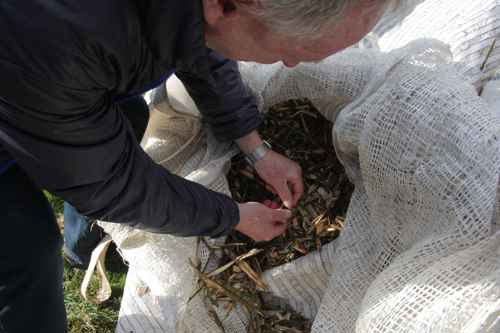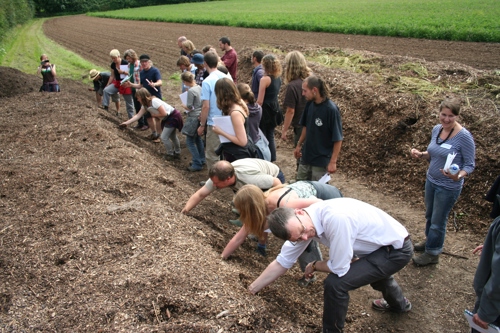Why woodchip could be the future
Most propagation substrates currently used in the UK contain peat. Its ability to hold water and nutrients well has made it an obvious choice for growers over the years. However, the negative impact on peatlands across the UK, and the world, has now become evident. Peatlands are the UK’s largest carbon sink, yet only 13% of our peatlands remain in a near-natural state due to extraction and degradation [1]. Yet, many growers are still relying on either peat-based substrates (also known as growing media) or peat-free composts that are shipped from Europe and do not perform as well.
As the sale of horticultural peat is set to be banned in the UK in 2024 – what are the alternatives?
Iain Tolhurst (Tolly) – co-founder of Tolhurst Organic – ditched peat over 30 years ago. “We had long-term concerns about the use of peat and gave it up on the grounds that I didn’t think it was sustainable,” Tolly said. When woodchip became available from a local tree surgeon, Tolly and his team started making their own woodchip compost and substrates on the farm and continue to do so today with much success.
In 2014, Tolly took part in an Innovative Farmers Field Lab that researched growing with peat-free woodchip substrates. The results of the trial revealed that woodchip substrates perform comparably to peat in terms of growth, health, and crop yields. We caught up with him to hear about his experience and find out the tips he’s learnt over the last 30 years of using woodchip compost.
The top three reasons to use woodchip as a substrate
Woodchip substrates increase health benefits to plants
Twenty years ago, Tolly and his team began growing their own trees to be turned into ramial chipped wood that is applied directly to the soil. Ramial chipped wood is woodchip made from younger branches less than 7cm in diameter.
It brings the forest to the farm with increased fungal activity in the soil and additional nutritional benefits. In the last five years, their yields have doubled. Research published by the Organic Research Centre in 2020 showed that the use of ramial woodchip at Tolhurst Organic resulted in a higher worm count, lower slug damage and larger brassicas with less downy mildew on their leaves [2].
“Woodchip has made a huge difference to our soil fertility – we've done a comprehensive carbon study of our soil, going down to a metre and we have higher carbon levels than our neighbouring farmer who is in permanent grassland which hasn’t been ploughed,” Tolly explained. He added, “We’ve reduced the area we grow on, primarily because our yields have gone up to the point where we don’t need to grow on such a large area”.
Woodchip substrate is sustainable
Whether you choose to buy woodchip from a local tree surgeon or grow the trees yourself, the material has a far lower carbon footprint than many growing media that commonly travel thousands of miles to reach the farm gate.
It’s a local product that’s produced using local materials and local labour – additionally, woodchip that could be a waste product from arboriculture is put back into the lifecycle and used to grow plants.
Woodchip compost creates a resilient fertility supply
Growing trees on-farm to be used specifically for woodchip creates a more holistic, closed-loop system that is far more resilient than relying on supply chains that may suddenly disappear. As the disruptions from the pandemic and the war in Ukraine have shown, supply chains can be cut off very swiftly.
Tolly added, “there’s a storm brewing where prices will go up, products will become less available, and growers are going to be pushed into a corner where they are going to have to make their own substrates.” The more growers who can make their own woodchip compost and produce propagation substrates from that, the more our agricultural economy will be immune from future global ruptures.
Common barriers to using woodchip substrates
- Access to material
Wood chip can be harder to source in some areas of the UK where there are less tree surgeons or those willing to pass it on to farmers. The process of growing trees on-farm to supply woodchip takes time. - Length of process
Wood chip can take over a year to rot down to be used as viable compost or substrate. - Lack of space to store compost
Ideally, a covered space is needed to store the compost - a tarpaulin would be an option, but not as convenient.

How to make your own woodchip compost and substrates
From his research and experience, Tolly recommends the following:
- Source your material
Growing trees for woodchip is the most holistic, secure way to source your material. If you know several farms in your surrounding area that want to make woodchip, you could group together to grow trees and share woodchip between you. You can start producing reasonable amounts of woodchip within five years. The next best option – or the way to source woodchip while waiting for your trees to grow – is to contact local tree surgeons in your area and see if they have woodchip that they can supply (you may need to pay a fee for this). - Site
The placement of your composting site is important. Vehicular access is essential – the site needs to be near a road or made up track. It needs to be well drained as materials will be arriving in wet winter periods and level or near to level. Avoid any areas close to water supplies and overhead cables. If you are using your woodchip compost to take green waste and old veg then it’s best to choose a site that’s away from habitations as rats may be a problem.
- Start the process
Leave the woodchip to rot down for 12 months to be applied to crops as compost. Leave it for 18 months to 2 years if you want to use it as a substrate to raise plants. The wood needs to completely break down to avoid any lock-up of nitrogen and it makes it a lot easier to sieve and grade (Tolly grades it to 10mm so that it’s easier to sieve).
While buying materials would be a quicker option, Tolly points out that “there’s more to this than just making woodchip, you gain enormously by making it on the farm yourself. Once you’ve got it and you keep the process going – you've got it forever.” - Turn the compost
Turn it roughly every 12 weeks and then put the potential substrate material to one side for a further six months (or until it’s completely rotted down). From this point you must store the material away from rain - to enable it to sieve easily it needs to be fairly dry. A tarpaulin will suffice but ideally store it under a simple roof with protection from rain on the windward side. You can add a small amount of green, veg or polytunnel waste but it should be primarily woodchip. - Apply it to crops or use it as a substrate
At Tolhurst Organic, woodchip is used in a very focused way. The amount applied to the land is very small and would seem useless to some growers. It is applied at a rate of around 70 cubic metres/ha directly to fertility building green manures that occupy two years of a seven year rotation. Tolly doesn’t see it as a big fertiliser but uses it more to add to the fungal activity and increase the carbon content of the soil. Many growers use woodchip for pathways, weed control or on raised bed systems. Tolly believes that the amount added is often far too much and could cause issues for the soil in the long term as too many nutrients and too much carbon is added.
As a substrate, Tolly has found that using woodchip has led to far greater reliability when raising plants. Over the last 30 years they have grown over two million plants and have never had a crop failure. The Innovative Farmers field lab on woodchip compost was one of the first to investigate this subject in around 40 years. Substrate performance is a big issue for many growers and more research is needed in this area.
Additionally, Tolly and his team have removed the need to produce a large amount of substrate as they grow many of their plants in soil (peg plants) and then move them, as was normal practice 50-60 years ago.

Growing your own trees for woodchip
At Tolhurst Organic, trees are seen as a crop in a similar way to vegetables. They have seven rows and cut one every year for woodchip, which compliments their seven-year vegetable rotation.
Willow is the primary tree species they grow for ramial chipped wood that is applied to crops as compost. Alde has also performed especially well. Currently, they continue to use woodchip from local tree surgeons for substrate to raise plants as they aren’t growing enough trees for all uses.
When growing trees for woodchip, younger branches are preferred. However, the size matters more than the age – ideally you want branches that measure less than 75mm. You don’t want too much conifer, leylandii or pine species (maximum 30%) as they can upset the composting process.
Tips for using woodchip in compost and substrates
All substrates will differ in terms of how you manage them. Peat holds more water than woodchip so you cannot expect to use them in the same way.
Tolly stresses that “the management of woodchip is down to the propagation area and how you establish your plants.” Getting your watering regime right is very important. Tolly and his team use gravel as a medium underneath their trays instead of capillary matting. This helps to hold moisture and keep the environment cool during the summer months.
Tolly makes around 6 or 7 cubic metres of woodchip compost per year – this equates to roughly £7000 worth and works out favourably financially vs buying compost in.
Costs:
Costings below are from 2015 so current inflation will add 25% to these figures
|
Raw woodchip |
No charge delivered free to the site by local tree surgeon. A waste transfer licence might be necessary from the local authority. |
£0.00 |
|
Turning |
Using 1.5 t digger, assuming production of 100 m3 p.a. Hire charge 3 days per annum Farm labour 3 days @ £80 |
£200.00 £240.00 |
|
Grading |
Material for compost production |
£160.00 |
|
Additional material |
(vermiculite) and mixing |
£500.00 |
|
Total |
approximately £1,100.00 or 11p per litre
|
|
If you want to find out more about using or making woodchip compost, Tolly does farm walks at Tolhurst Organic (some of which are focused on his woodchip composting process). Additionally, 'The Woodchip Handbook: A complete guide for farmers, gardeners and landscapers' by Ben Raskin is another great resource for further learning.
____________________________________________
References:
[1] https://www.gov.uk/government/news/sale-of-horticultural-peat-to-be-banned-in-move-to-protect-englands-precious-peatlands
[2] https://www.organicresearchcentre.com/wp-content/uploads/2020/12/WOOFS_TG2_Final.pdf